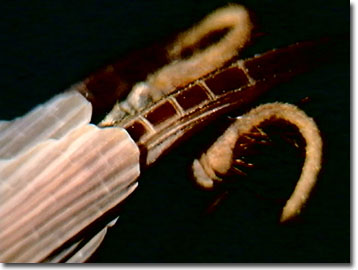Reflected Light Digital Image Gallery
Southern Mole Cricket (Scapteriscus borellii)
The southern mole cricket, a member of the family Gryllotalpidae in the order Orthoptera, is considered a pest insect species from North Carolina to Texas. It was introduced about 1900 into Florida and Georgia from southern South America. Unlike most mole crickets that feed on decomposing organic matter and roots, the nymphs and adults of the southern mole cricket are largely carnivorous, tunneling beneath turf and pasture grasses, creating damage.

View a second image of a southern mole cricket (Scapteriscus borellii).
View a third image of a southern mole cricket (Scapteriscus borellii).
Adult mole crickets are about 32 millimeters long, are brown, and covered with fine, short hairs. The bodies of Scapteriscus borellii feature front legs modified for digging, short front wings, and long, membranous hind wings. The nymphs and adults are similar in morphology except that the nymphs are smaller and wingless. A female southern mole cricket lays about 35 3.3-millimeter diameter oval eggs, in cells constructed in the soil during the spring. Ten to 40 days later (depending on the temperature), the eggs hatch, and the emerged nymphs molt approximately 6 times before maturity. In most cases, one generation occurs per year and the orthopterans overwinter either as adults or nymphs.
A relatively slim and active mole cricket with wings longer than its body, the southern mole cricket will play dead when captured, but then suddenly move rapidly. There are two morphs extant in Florida, the mottled and four-dot, which are distinguished by patterns on the thorax. Usually, the mottled form is found in northern Florida and southern Georgia, while the four-dot occurs in peninsular Florida. However, the specimen presented here, although collected in Tallahassee, Florida (in the spring of 2002), is the four-dot type. Females in Florida will fly from October through November to disperse before ovipositing their eggs. In southern Florida, the agricultural pest may complete two generations per year while in northern Florida and Georgia, one generation per year is the rule. Unlike their largely herbivorous cousins, the southern mole cricket feeds mostly on insects and other soil-inhabiting invertebrates. As one benefit to humans and farm animals, S. borellii feeds on ants and may include fire ants in its diet.
Control methods for the southern mole cricket include the more traditional application of insecticides as well as less toxic alternatives such as South American introduced nematodes (Steinema scapterisci), tachinid flies (Ormia depleta), and sphecid wasps (Larra bicolor) that parasitize the mole crickets. There are also several native species of mole cricket in the United States as well as six other exotics that have become established.
Contributing Authors
Cynthia D. Kelly, Thomas J. Fellers and Michael W. Davidson - National High Magnetic Field Laboratory, 1800 East Paul Dirac Dr., The Florida State University, Tallahassee, Florida, 32310.
BACK TO THE REFLECTED LIGHT IMAGE GALLERY
BACK TO THE DIGITAL IMAGE GALLERIES
Questions or comments? Send us an email.
© 1995-2025 by Michael W. Davidson and The Florida State University. All Rights Reserved. No images, graphics, software, scripts, or applets may be reproduced or used in any manner without permission from the copyright holders. Use of this website means you agree to all of the Legal Terms and Conditions set forth by the owners.
This website is maintained by our
Graphics & Web Programming Team
in collaboration with Optical Microscopy at the
National High Magnetic Field Laboratory.
Last Modification Friday, Nov 13, 2015 at 01:19 PM
Access Count Since September 17, 2002: 8941
Visit the website of our partner in introductory microscopy education:
|
|
